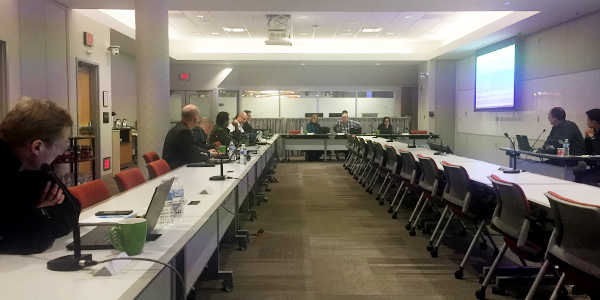By Rory D. Sweeney
VALLEY FORGE — PJM is nearing the finish line in determining how it handles the primary frequency response (PFR) requirements put in place by FERC Order 842.
Stakeholders and staff put the final touches on the three remaining proposals at Tuesday’s meeting of the Primary Frequency Response Senior Task Force. (See “Primary Frequency Response Moving Forward,” PJM Operating Committee Briefs: Nov. 6, 2018.)
The proposals differ on thresholds for inclusion in the requirement, and on whether and how units that provide the service should receive separate compensation. A fourth proposal, offered by American Electric Power, has been removed.
Still under contention within PJM’s proposal is whether units can claim exemptions from the PFR requirements if installing the necessary technology would be prohibitively expensive. The RTO had added language that exemptions could not be justified “solely” on economic grounds, but Howard Haas of Monitoring Analytics, the Independent Market Monitor, said that a technical exemption should only be allowed if there is a “physical restriction that cannot be rectified using available commercial alternatives.”
He said the market should determine whether a commercial solution is economically feasible, and the requirement would remain either way.
PJM’s Vince Stefanowicz agreed that the rule should be that economics cannot be used as an exemption criteria.
“It sounds like we muddied the water” with the revisions, he said. “I’m actually inclined to go back to the original wording.”
PJM staff joked that removing the revision would leave the proposal “sole-less,” and Haas agreed.
“It would be ‘sole-less,’ just as economics should be,” he said.
But Bob O’Connell of Panda Power Funds and FirstEnergy’s Jim Benchek criticized the removal, arguing that prohibitive cost should be a consideration in approving exemptions.
PJM’s Glen Boyle said that equipment manufacturers provided feedback to staff that the necessary solutions are commercially available and low-cost. O’Connell asked for that understanding to be documented in the revisions.
Additional Discussions
David “Scarp” Scarpignato asked PJM to analyze whether units at 100% maximum output can receive an exemption from evaluation of PFR performance during a frequency event in the same way that units aren’t evaluated when at minimum output during an event. Staff agreed to review wording.
Staff also agreed to work with the Monitor on agreeing to a single megawatt threshold for aggregated resources under which they would be exempt from providing PFR. Currently, the Monitor’s proposal has a 10-MW threshold while PJM’s is 20 MW.
They also said they would provide a PFR market solution “if one becomes viable.” Calpine’s proposal calls for allowing units that produce more PFR than required to sell it. PJM is concerned how that would work for system restoration.
“The short answer is I’m not sure how you’d do that,” Stefanowicz said.
While PJM and the Monitor are attempting to avoid FERC-approved cost recovery similar to how reactive service is paid, stakeholders complained that the proposed process — in which PJM and its Monitor agree on a fair rate — doesn’t allow for due process for the unit seeking the rate while commission approval does. They asked PJM and the Monitor to develop language to determine standards and how the process will occur.
Next Steps
Reconciliation of the revisions should happen soon, staff confirmed.
“I think it can be resolved pretty quickly,” Boyle said.
Staff plan to open a one-week poll on the proposals that will close on Dec. 3 and have the results ready to review for the task force’s next meeting on Dec. 5. Packages that receive at least 50% support will receive a first read at the Dec. 20 meeting of the Markets and Reliability Committee. The proposal with the most support will be the main motion, and any others that meet the threshold will be considered as alternates.
The proposals will then be offered for consideration at the Jan. 24 meeting of the MRC and Members Committee. Endorsement on that timeline would lead to a filing at FERC in early February, PJM’s Jim Burlew said, and the RTO likely would seek an effective date of 60 days after approval. That would trigger the beginning of PJM tracking units’ performance during PFR events. However, as part of PJM’s implementation timeline, repercussions of the scoring, including referral to FERC enforcement, wouldn’t take effect for two years following FERC approval.
The poll will also include a question about whether stakeholders prefer a change to the status quo. If no proposal receives at least 50% or if the vote shows a preference for the status quo, staff will provide the results as part of the task force’s update and ask the MRC for further direction. Boyle indicated that, in that case, the RTO might decide to file a proposal for FERC approval without stakeholder endorsement under Section 206 of the Federal Power Act.
“I don’t think PJM would consider status quo an acceptable outcome,” Boyle said.



